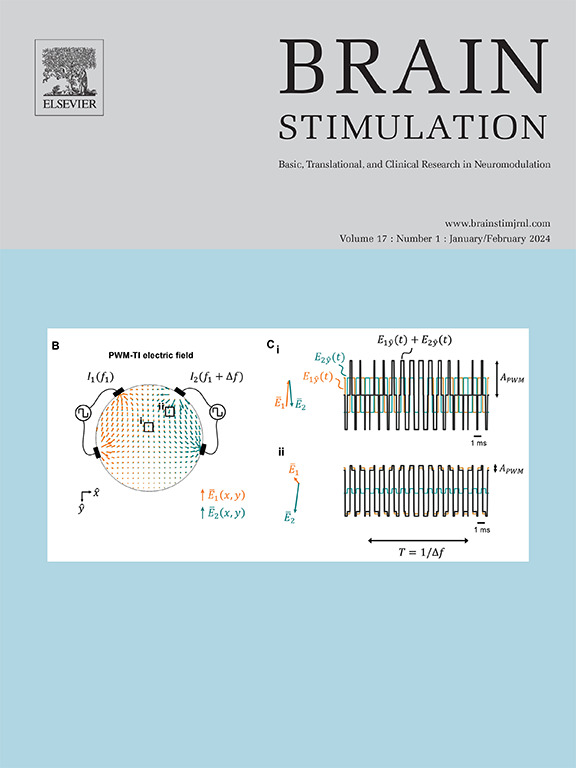灵活和稳定的周期锁相脑深部刺激系统针对大脑振荡在运动障碍管理。
IF 8.4
1区 医学
Q1 CLINICAL NEUROLOGY
引用次数: 0
摘要
背景:精确定时的脑刺激,如锁相深部脑刺激(PLDBS),为通过增强或抑制特定振荡来调节功能失调的神经网络提供了一种很有前途的方法。然而,它的临床应用一直受到缺乏用户友好的系统和在刺激伪影中实时相位估计的挑战。材料和方法:在这项工作中,我们开发了一个临床可翻译的PLDBS框架,使用标准放大器和计算机在环系统实现实时、逐周期刺激。我们的方法集成了基于卡尔曼滤波的伪影抑制和非谐振振荡器,以实现精确的相位跟踪。我们在一项小型临床试验中测试了该系统,该试验针对运动障碍患者在深部脑刺激手术后急性铅外化期间的皮层α和STN β节律的特定阶段进行丘脑下核(STN)刺激。结果:该系统对STN β和皮层α的刺激准确度高于预期。在不同的STN β阶段进行的刺激导致所有参与者的STN局部场电位的诱发电位存在显著差异。STN β触发的刺激显示帕金森病患者手指敲击速度和振幅的潜在相位依赖性调节。结论:本研究为具有ce标志器件和计算机在环的精密PLDBS提供了灵活稳定的管道。利用这一管道,我们发现不同STN β相的PLDBS对STN的诱发动作电位和用于量化运动迟缓的运动行为有差异调节,为PLDBS的进一步研究和临床试验铺平了道路。本文章由计算机程序翻译,如有差异,请以英文原文为准。
Flexible and stable cycle-by-cycle phase-locked deep brain stimulation system targeting brain oscillations in the management of movement disorders
Background
Precisely timed brain stimulation, such as phase-locked deep brain stimulation (PLDBS), offers a promising approach to modulating dysfunctional neural networks by enhancing or suppressing specific oscillations. However, its clinical application has been hindered by the lack of user-friendly systems and the challenge of real-time phase estimation amid stimulation artifacts.
Material and method
In this work, we developed a clinically translatable PLDBS framework that enables real-time, cycle-by-cycle stimulation using standard amplifiers and a computer-in-the-loop system. Our approach integrates Kalman filter-based artifact suppression and non-resonant oscillators for accurate phase tracking. We tested this system in a small clinical trial () targeting subthalamic nucleus (STN) stimulation at specific phases of cortical alpha and STN beta rhythms in patients with movement disorders during acute lead externalization following deep brain stimulation surgery.
Result
The system delivered stimulation with over accuracy, within for STN beta and for cortical alpha. Stimulations delivered at different STN beta phases led to a significant difference in evoked potentials in STN local field potentials in all participants. STN beta-triggered stimulation showed potential phase-dependent modulation of finger-tapping velocity and amplitude in Parkinson's disease.
Conclusion
This study presents a flexible and stable pipeline for precise PLDBS with CE-marked devices and a computer-in-the-loop. Using this pipeline, we showed that PLDBS at different STN beta phases differentially modulates the evoked action potentials in the STN and motor behavior used to quantify bradykinesia, paving the way for further studies and clinical trials for PLDBS.
求助全文
通过发布文献求助,成功后即可免费获取论文全文。
去求助
来源期刊

Brain Stimulation
医学-临床神经学
CiteScore
13.10
自引率
9.10%
发文量
256
审稿时长
72 days
期刊介绍:
Brain Stimulation publishes on the entire field of brain stimulation, including noninvasive and invasive techniques and technologies that alter brain function through the use of electrical, magnetic, radiowave, or focally targeted pharmacologic stimulation.
Brain Stimulation aims to be the premier journal for publication of original research in the field of neuromodulation. The journal includes: a) Original articles; b) Short Communications; c) Invited and original reviews; d) Technology and methodological perspectives (reviews of new devices, description of new methods, etc.); and e) Letters to the Editor. Special issues of the journal will be considered based on scientific merit.
 求助内容:
求助内容: 应助结果提醒方式:
应助结果提醒方式:


